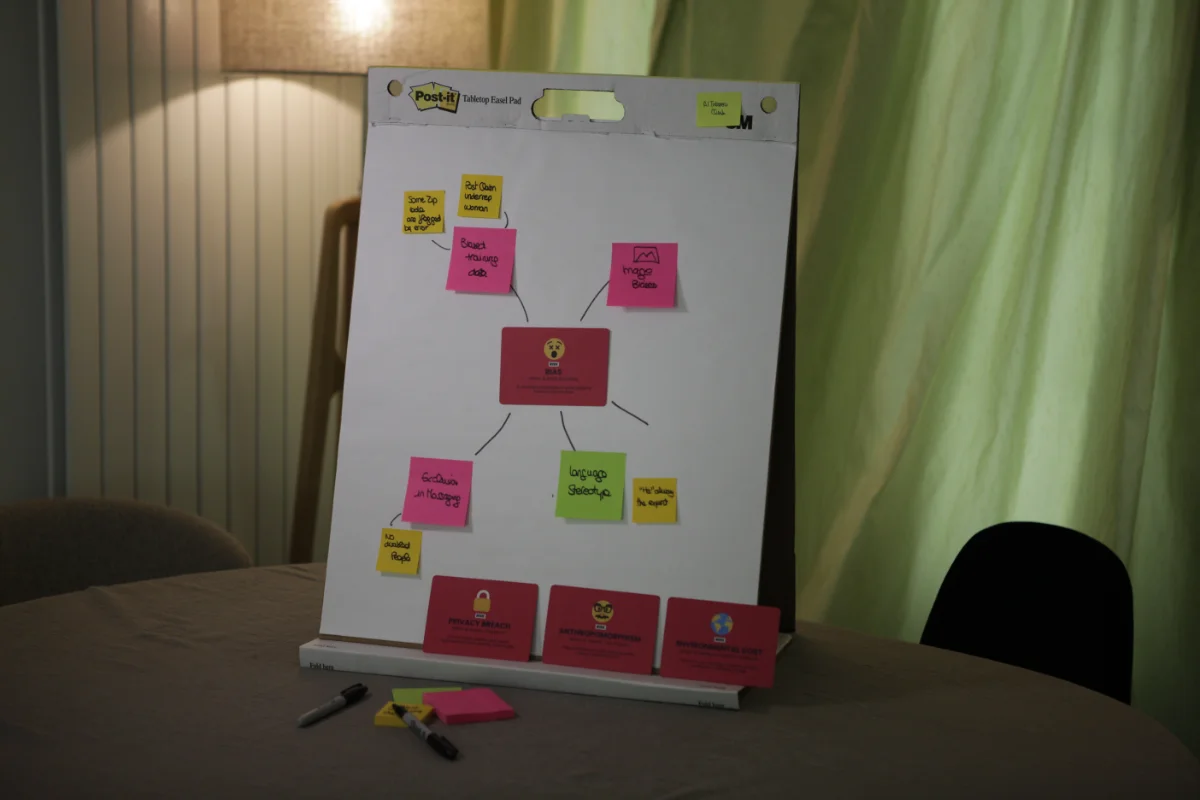Mind Mapping AI Risks
When to Use This Activity
I use this activity when I want participants to move beyond theoretical understanding of AI risks and explore how these risks might actually manifest in their work context. It's particularly effective:
- After introducing basic AI concepts
- When participants seem overconfident about AI safety
- To prepare teams for responsible AI implementation
- As a foundation before discussing risk mitigation strategies

Key Learning Outcomes
- Transform abstract AI risk concepts into concrete, relatable scenarios
- Identify potential AI risks specific to participants' work contexts
- Foster collaborative discussion about responsible AI use
- Build shared understanding of risk awareness across teams
Cards
You'll need one risk card per group. I typically use these from the 1€ Starter Kit and the upcoming risk expansion pack:
Materials Needed
- Post-it® Tabletop Easel Pads or large sheets of paper (one per group)
- Post-it notes in different colors
- Markers
- Patafix or tape to secure cards
- Optional: QR code scanner for accessing real-world examples
Step-by-Step Guide
Step 1: Setup and Card Assignment
I start by dividing participants into groups of 4-6 people. Each group gets:
- One large sheet of paper or easel pad
- One AI risk card
- Colored post-it notes
- Markers
I place the risk card in the center of each sheet and secure it with Patafix.
Each group will explore one specific AI risk. Your job is to make this risk real and relevant to your daily work.
Step 2: Grounding in Reality
Before starting the mind map, I have each group scan the QR code on their card to read a real-world example of their assigned risk.
Start by reading the real-world example together. This isn't theoretical—these risks have already happened to real organizations.
Groups spend 3-4 minutes discussing the example and understanding how the risk manifested in practice.
Step 3: Building the Mind Map
Now I guide them through creating their mind map around the risk card:
Using post-it notes, brainstorm how this risk could show up in your organization or work. Think about:
- Specific situations where this might happen
- Warning signs you might notice
- Who would be affected
- What the consequences could be
I encourage them to organize their thoughts however makes sense—branches, clusters, color coding by theme.
Step 4: Making It Personal
After 10-15 minutes of general brainstorming, I add this challenge:
Now think about your specific role and responsibilities. Add notes about how this risk could specifically impact your work or decisions.
This helps move from abstract understanding to personal relevance.
Step 5: Gallery Walk and Cross-Pollination
Groups rotate to visit other tables' mind maps. I give them 2-3 minutes per station to:
- Read what other groups identified
- Add new insights they hadn't considered
- Use a different colored post-it to mark ideas that surprise them
Step 6: Synthesis and Reflection
Back at their original tables, groups reflect on what they learned from other mind maps:
What patterns did you notice across different risks? What surprised you most about risks outside your assigned one?
Facilitation Tips
Keep It Grounded
When discussions get too abstract, I redirect with:
Give me a specific example of how this would happen in your workplace tomorrow.
Handle Resistance
You'll encounter two types of resistance. Some participants might think risks are overblown, while others become so concerned about risks they want to avoid AI entirely. I handle both by keeping the focus practical:
For risk minimizers:
You're right that not every risk happens every time. But when they do happen, the impact is real. Let's explore what that looks like.
For risk-averse participants:
These risks are real, but they're manageable. The goal isn't to avoid AI—it's to use it responsibly. Let's identify what we need to watch for so we can benefit from AI safely.
Variants and Extensions
Digital Version
For virtual sessions, I use the Miro template from the Base Game. Each group gets their own frame with a risk card, and they can collaborate just like with physical post-its.
Large Group Version
With 20+ participants, I assign the same risk to multiple groups, then have them compare approaches:
Two groups explored bias—let's see if you identified the same risks or found completely different angles.
Industry-Specific Focus
I adapt the prompt for specific contexts:
How might this risk manifest in healthcare/finance/education specifically?
Mitigation Follow-Up
After mapping risks, groups brainstorm mitigation strategies:
Now that you've identified these risks, what could you do to prevent or reduce them?
Executive Version
For leadership teams, I focus on organizational impact:
What would this risk mean for our company's reputation, compliance, or competitive position?
Resources and References
- Each risk card includes a QR code linking to documented real-world examples
What's Next
After this activity, participants are well-prepared for:
- Risk Mitigation Planning to develop specific countermeasures
- Creating Responsible AI Guidelines to create team agreements
- More advanced risk assessment activities focused on their specific use cases